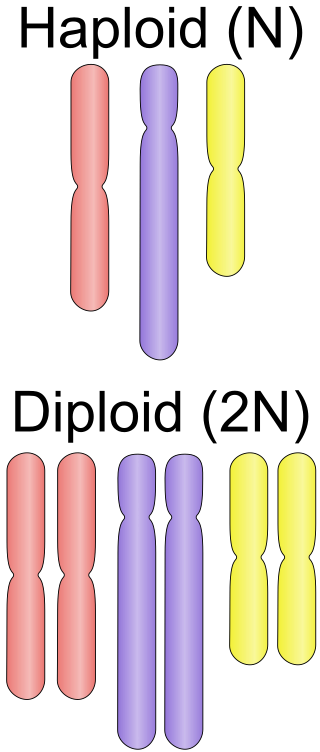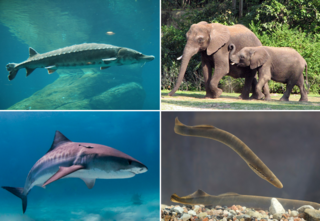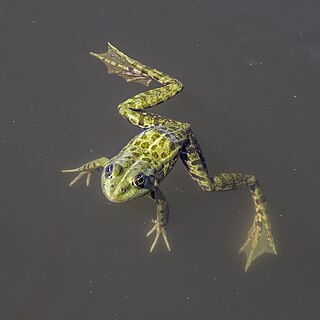
Asexual reproduction is a type of reproduction that does not involve the fusion of gametes or change in the number of chromosomes. The offspring that arise by asexual reproduction from either unicellular or multicellular organisms inherit the full set of genes of their single parent and thus the newly created individual is genetically and physically similar to the parent or an exact clone of the parent. Asexual reproduction is the primary form of reproduction for single-celled organisms such as archaea and bacteria. Many eukaryotic organisms including plants, animals, and fungi can also reproduce asexually. In vertebrates, the most common form of asexual reproduction is parthenogenesis, which is typically used as an alternative to sexual reproduction in times when reproductive opportunities are limited. Komodo dragons and some monitor lizards can reproduce asexually.

Ploidy is the number of complete sets of chromosomes in a cell, and hence the number of possible alleles for autosomal and pseudoautosomal genes. Sets of chromosomes refer to the number of maternal and paternal chromosome copies, respectively, in each homologous chromosome pair, which chromosomes naturally exist as. Somatic cells, tissues, and individual organisms can be described according to the number of sets of chromosomes present : monoploid, diploid, triploid, tetraploid, pentaploid, hexaploid, heptaploid or septaploid, etc. The generic term polyploid is often used to describe cells with three or more sets of chromosomes.

Reproduction is the biological process by which new individual organisms – "offspring" – are produced from their "parent" or parents. There are two forms of reproduction: asexual and sexual.

Vertebrates are deuterostomal animals with bony or cartilaginous axial endoskeleton — known as the vertebral column, spine or backbone — around and along the spinal cord, including all fish, amphibians, reptiles, birds and mammals. The vertebrates consist of all the taxa within the subphylum Vertebrata and represent the overwhelming majority of the phylum Chordata, with currently about 69,963 species described.

Fertilisation or fertilization, also known as generative fertilisation, syngamy and impregnation, is the fusion of gametes to give rise to a zygote and initiate its development into a new individual organism or offspring. While processes such as insemination or pollination, which happen before the fusion of gametes, are also sometimes informally referred to as fertilisation, these are technically separate processes. The cycle of fertilisation and development of new individuals is called sexual reproduction. During double fertilisation in angiosperms, the haploid male gamete combines with two haploid polar nuclei to form a triploid primary endosperm nucleus by the process of vegetative fertilisation.

In botany, apomixis is asexual development of seed or embryo without fertilization. However, other definitions include replacement of the seed by a plantlet or replacement of the flower by bulbils.

The mole salamanders are a group of advanced salamanders endemic to North America. The group has become famous due to the presence of the axolotl, widely used in research due to its paedomorphosis, and the tiger salamander which is the official amphibian of many US states, and often sold as a pet.

The edible frog is a species of common European frog, also known as the common water frog or green frog.

The blue-spotted salamander is a mole salamander native to the Great Lakes states and northeastern United States, and parts of Ontario and Quebec in Canada. Their range is known to extend to James Bay to the north, and southeastern Manitoba to the west.

Fish reproductive organs include testes and ovaries. In most species, gonads are paired organs of similar size, which can be partially or totally fused. There may also be a range of secondary organs that increase reproductive fitness. The genital papilla is a small, fleshy tube behind the anus in some fishes, from which the sperm or eggs are released; the sex of a fish can often be determined by the shape of its papilla.

Thelytoky is a type of parthenogenesis and is the absence of mating and subsequent production of all female diploid offspring as for example in aphids. Thelytokous parthenogenesis is rare among animals and reported in about 1,500 species, about 1 in 1000 of described animal species, according to a 1984 study. It is more common in invertebrates, like arthropods, but it can occur in vertebrates, including salamanders, fish, and reptiles such as some whiptail lizards.

Parthenogenesis is a natural form of asexual reproduction in which growth and development of an embryo occur directly from an egg, without need for fertilisation. In animals, parthenogenesis means development of an embryo from an unfertilized egg cell. In plants, parthenogenesis is a component process of apomixis. In algae, parthenogenesis can mean the development of an embryo from either an individual sperm or an individual egg.
The silvery salamander is a hybrid species of mole salamander from the United States of America and Canada. It is usually between 5.5–7.75 in (14.0–19.7 cm) long and is slender with many small silvery-blue spots on its back and sides. It is brownish grey and the area around its vent is grey. A unisexual Ambystoma hybrid species, Ambystoma platineum has been grouped with other unisexual ambystomatids that takes genetic material from Jefferson salamanders, streamside salamanders, small-mouthed salamanders, tiger salamanders and the blue-spotted salamander.

Sexual reproduction is a type of reproduction that involves a complex life cycle in which a gamete with a single set of chromosomes combines with another gamete to produce a zygote that develops into an organism composed of cells with two sets of chromosomes (diploid). This is typical in animals, though the number of chromosome sets and how that number changes in sexual reproduction varies, especially among plants, fungi, and other eukaryotes.

In biology, a klepton and synklepton is a species that requires input from another biological taxon to complete its reproductive cycle. Specific types of kleptons are zygokleptons, which reproduce by zygogenesis; gynokleptons which reproduce by gynogenesis, and tychokleptons, which reproduce by a combination of both systems.
Parthenogenesis is a mode of asexual reproduction in which offspring are produced by females without the genetic contribution of a male. Among all the sexual vertebrates, the only examples of true parthenogenesis, in which all-female populations reproduce without the involvement of males, are found in squamate reptiles. There are about 50 species of lizard and 1 species of snake that reproduce solely through parthenogenesis. It is unknown how many sexually reproducing species are also capable of parthenogenesis in the absence of males, but recent research has revealed that this ability is widespread among squamates.

The fertile hybrids of European water frogs reproduce by hybridogenesis (hemiclonally). This means that during gametogenesis, they discard the genome of one of the parental species and produce gametes of the other parental species. The first parental genome is restored by fertilization of these gametes with gametes from the first species. In all-hybrid populations of the edible frog Pelophylax kl. esculentus, however, triploid hybrids provide this missing genome.
Autogamy or self-fertilization refers to the fusion of two gametes that come from one individual. Autogamy is predominantly observed in the form of self-pollination, a reproductive mechanism employed by many flowering plants. However, species of protists have also been observed using autogamy as a means of reproduction. Flowering plants engage in autogamy regularly, while the protists that engage in autogamy only do so in stressful environments.
Gynogenesis, a form of parthenogenesis, is a system of asexual reproduction that requires the presence of sperm without the actual contribution of its DNA for completion. The paternal DNA dissolves or is destroyed before it can fuse with the egg. The egg cell of the organism is able to develop, unfertilized, into an adult using only maternal genetic material. Gynogenesis is often termed "sperm parasitism" in reference to the somewhat pointless role of male gametes. Gynogenetic species, "gynogens" for short, are unisexual, meaning they must mate with males from a closely related bisexual species that normally reproduces sexually.
Androgenesis occurs when a zygote is produced with only paternal nuclear genes. During standard sexual reproduction, one female and one male parent each produce haploid gametes, which recombine to create offspring with genetic material from both parents. However, in androgenesis, there is no recombination of maternal and paternal chromosomes, and only the paternal chromosomes are passed down to the offspring. The offspring produced in androgenesis will still have maternally inherited mitochondria, as is the case with most sexually reproducing species.















